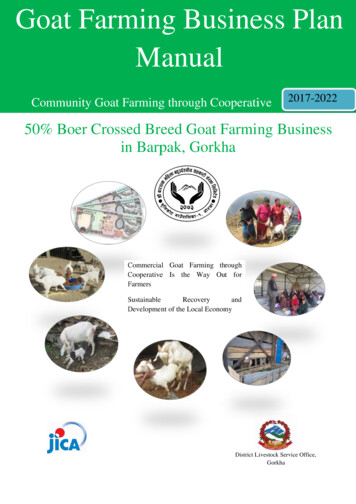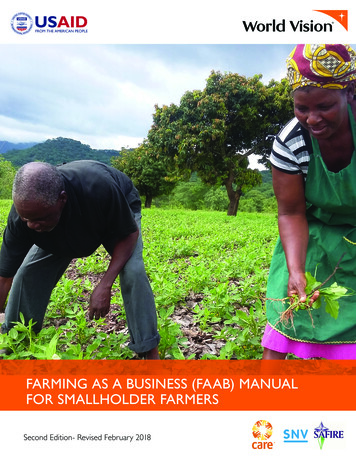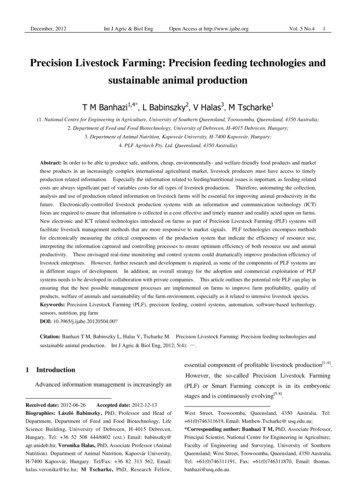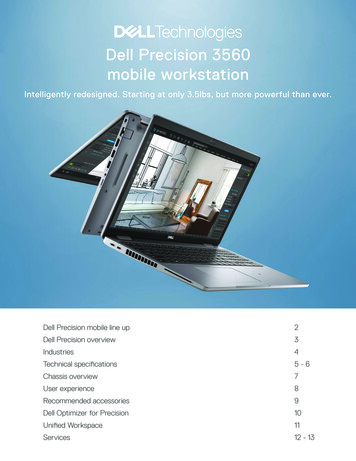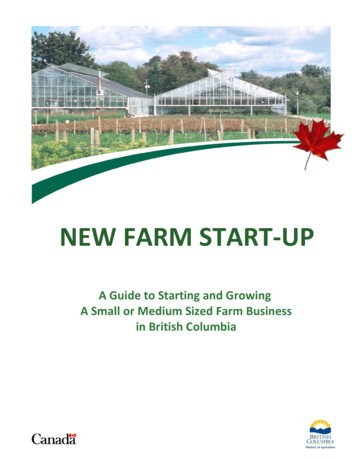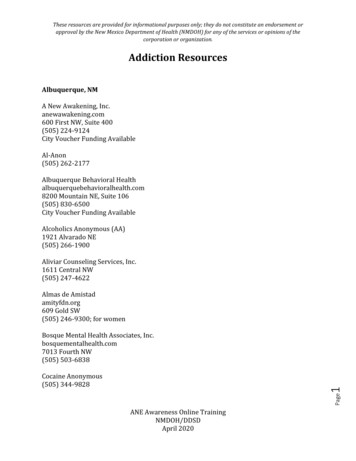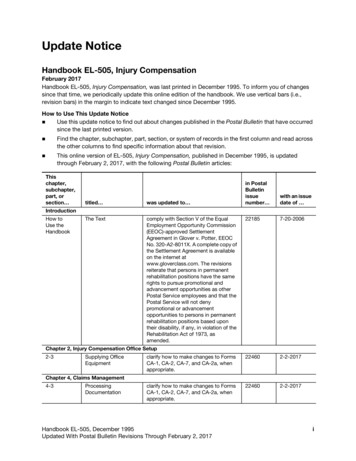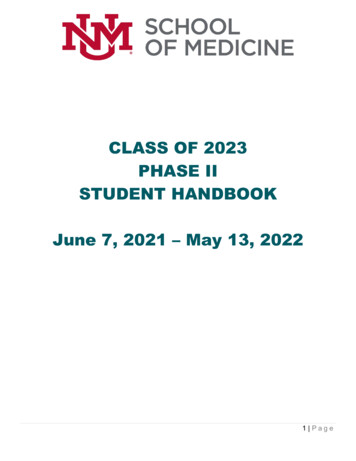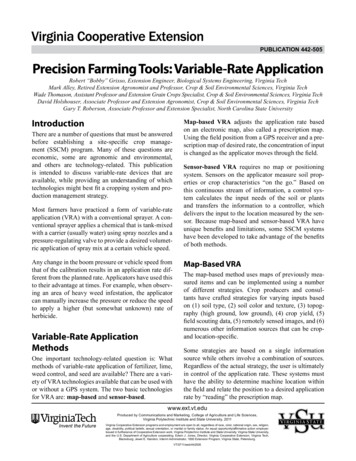
Transcription
PUBLICATION 442-505Precision Farming Tools: Variable-Rate ApplicationRobert “Bobby” Grisso, Extension Engineer, Biological Systems Engineering, Virginia TechMark Alley, Retired Extension Agronomist and Professor, Crop & Soil Environmental Sciences, Virginia TechWade Thomason, Assistant Professor and Extension Grain Crops Specialist, Crop & Soil Environmental Sciences, Virginia TechDavid Holshouser, Associate Professor and Extension Agronomist, Crop & Soil Environmental Sciences, Virginia TechGary T. Roberson, Associate Professor and Extension Specialist, North Carolina State UniversityIntroductionMap-based VRA adjusts the application rate basedon an electronic map, also called a prescription map.Using the field position from a GPS receiver and a prescription map of desired rate, the concentration of inputis changed as the applicator moves through the field.There are a number of questions that must be answeredbefore establishing a site-specific crop management (SSCM) program. Many of these questions areeconomic, some are agronomic and environmental,and others are technology-related. This publicationis intended to discuss variable-rate devices that areavailable, while providing an understanding of whichtechnologies might best fit a cropping system and production management strategy.Sensor-based VRA requires no map or positioningsystem. Sensors on the applicator measure soil properties or crop characteristics “on the go.” Based onthis continuous stream of information, a control system calculates the input needs of the soil or plantsand transfers the information to a controller, whichdelivers the input to the location measured by the sensor. Because map-based and sensor-based VRA haveunique benefits and limitations, some SSCM systemshave been developed to take advantage of the benefitsof both methods.Most farmers have practiced a form of variable-rateapplication (VRA) with a conventional sprayer. A conventional sprayer applies a chemical that is tank-mixedwith a carrier (usually water) using spray nozzles and apressure-regulating valve to provide a desired volumetric application of spray mix at a certain vehicle speed.Any change in the boom pressure or vehicle speed fromthat of the calibration results in an application rate different from the planned rate. Applicators have used thisto their advantage at times. For example, when observing an area of heavy weed infestation, the applicatorcan manually increase the pressure or reduce the speedto apply a higher (but somewhat unknown) rate ofherbicide.Map-Based VRAThe map-based method uses maps of previously measured items and can be implemented using a numberof different strategies. Crop producers and consultants have crafted strategies for varying inputs basedon (1) soil type, (2) soil color and texture, (3) topography (high ground, low ground), (4) crop yield, (5)field scouting data, (5) remotely sensed images, and (6)numerous other information sources that can be cropand location-specific.Variable-Rate ApplicationMethodsSome strategies are based on a single informationsource while others involve a combination of sources.Regardless of the actual strategy, the user is ultimatelyin control of the application rate. These systems musthave the ability to determine machine location withinthe field and relate the position to a desired applicationrate by “reading” the prescription map.One important technology-related question is: Whatmethods of variable-rate application of fertilizer, lime,weed control, and seed are available? There are a variety of VRA technologies available that can be used withor without a GPS system. The two basic technologiesfor VRA are: map-based and sensor-based.www.ext.vt.eduProduced by Communications and Marketing, College of Agriculture and Life Sciences,Virginia Polytechnic Institute and State University, 2011Virginia Cooperative Extension programs and employment are open to all, regardless of race, color, national origin, sex, religion,age, disability, political beliefs, sexual orientation, or marital or family status. An equal opportunity/affirmative action employer.Issued in furtherance of Cooperative Extension work, Virginia Polytechnic Institute and State University, Virginia State University,and the U.S. Department of Agriculture cooperating. Edwin J. Jones, Director, Virginia Cooperative Extension, Virginia Tech,Blacksburg; Jewel E. Hairston, Interim Administrator, 1890 Extension Program, Virginia State, Petersburg.1VT/0711/web/442505
For example, to develop a prescription map for nutrientVRA in a particular field, the map-based method couldinclude the following steps:What is a prescription map? A prescription map isan electronic data file containing specific informationabout input rates to be applied in every zone of a field. Perform systematic soil sampling (and lab analysis)for the field. Generate site-specific maps of the soil nutrientproperties of interest. Use an algorithm to develop a site-specific nutrientprescription map. Use the prescription map to control a fertilizer variable-rate applicator.What is remote sensing? Remote sensing is the science and art of acquiring information about the earth’ssurface without actually coming in contact with it. Thisis done by recording energy, which is either reflectedor emitted from the earth’s surface. The informationrecorded is then processed and analyzed, and the information is used to develop a prescription map that canbe used in a variable-rate application.A positioning system is used during the sampling andapplication steps to record location of the samplingpoints in the field and to apply the prescribed nutrientrates in the appropriate areas of the field.How does VRA increase economic potential? VRAincreases your economic return by strategically optimizing inputs in each management zone. VRA allowsyou to focus inputs on management zones that providethe highest return, while reducing inputs in lower productivity zones or where previous management hasresulted in a situation for reduced input need.Sensor-Based VRAThe sensor-based method provides the capability tovary the application rate of inputs with no prior mappingor data collection involved. Real-time sensors measurethe desired properties — usually soil properties or cropcharacteristics — while on the go. Measurements madeby such a system are then processed and used immediately to control a variable-rate applicator.Seeding VRAPlanters and drills can be made into VRA seeders byadjusting the speed of the seed-metering drive. Thiswill effectively change the plant population. VRAseeding is accomplished by separating or disconnecting the planter’s seed-meter systems from the grounddrive wheel. By attaching a motor or gear box (tochange speed of the ground wheel input), the seedingrate can be varied on the go. Most of these devices willbe matched with a prescription map and can have twoor more rates. A two-rate scenario may be a system thatreduces the seeding rates outside of the reach of a center-pivot irrigation system, while multiple rates may beneeded to adjust for soil types (water-holding capacity)and organic matter.The sensor method doesn’t necessarily require the useof a positioning system, nor does it require extensivedata analysis prior to making variable-rate applications.However, if the sensor data are recorded and geo-referenced, the information can be used in future site-specificcrop management exercises for creating a prescriptionmap for other and future operations, as well as to providean “as applied” application record for the grower.VRA FAQsAn example of a commercial system is available fromTrimble Inc. ion-Solution.aspx?dtID overview); it includes ahydraulic drive unit, processor, and groundspeed sensor. Ahydraulic motor (powered by tractor hydraulics) is attachedto an electric stepper motor (figure 1) to control the speeddelivered to the seed-meter shaft (figure 2).What is VRA? VRA is an abbreviation for variablerate application, which is a method of applying varyingrates of inputs in appropriate zones throughout a field.The goals of VRA are to maximize profit to its fullestpotential, create efficiencies in input application, andensure sustainability and environmental safety.What are VRA management zones? VRA management zones illustrate the natural variability of a fieldand are used to manage the VRA of inputs across thefield. On average, most fields have five different zones,but this varies with the field (see Interpreting YieldMaps: I Gotta Yield Map — Now What? VCE publication 442-509).A controller receives a groundspeed signal and coordinates the speed with planter width and seeding rate tosend a signal to the hydraulic drive. On some planters/drills, the seeding rates are matched with the application rates of fertilizer, herbicides, or insecticide unitsbecause they are driven by the same meter shaft.2
There is development of using on-the-go sensors toVRA seeding (figure 3). There are soil organic matter(SOM) sensors that detect different levels of organicmatter and adjust the plant population rate accordingly.Soil moisture meters that may be used for depth adjustment and for changing seeding rates are available.Weed Control VRAFor map-based weed control VRA systems, some formof “task computer” is required to provide a signal indicating the target rate for the current location. Second, asystem for physically changing the application rate tomatch the current prescribed rate is required.Figure 1. Hydraulic motor to control seed meter (PAR2 Variable Rate Drive; ion-Solution.aspx?dtID overview).There are a number of different types of control systems on the market today that are adaptable to VRA.Three categories will be discussed:1. Flow-based control of a tank mix.2. Chemical-injection-based control, with the subset,chemical-injection control with carrier.3. Modulated spraying-nozzle control system.Incidentally, all of these systems evolved out of thedesire to automatically match application rates to variations in groundspeed.These systems eliminate much of the error in application that could occur if groundspeeds change from thecalibrated setup. With the application rate managed byan electronic system, the ability to apply variable ratesis a logical next step. This requires that the prescribedapplication rate, or “set point,” be changeable according to the rate prescribed for that location.controllerprocessorcontroller outputsensorreadingsvariable-ratedrivesensorFigure 2. Hydraulic motor attached to theseed-meter shaft (Trimble Variable RateControllers; ion-Solution.aspx?dtID overview).Figure 3. “On-the-go” sensor (texture, electrical conductivity (EC), or soilorganic matter (SOM)) measures soil characteristics before planting andadjusting the seeding rate (plant population).3
Chemical injection eliminates leftover tank mix andreduces chemical exposure during tank mixing. Anadditional advantage of this system is that the constantflow of carrier can be adjusted to operate the boomnozzles to provide the optimum desirable size and distribution of spray droplets. The principal disadvantagefor variable-rate control is the long transport delaybetween the chemical-injection pump and the dischargenozzles at the ends of the boom. The volume withinthe spray plumbing (hoses and attachments) must beapplied before the new rate reaches the nozzles. Thiscan cause delays in the rate change and “Christmastree” patterns of application as the new concentrationof chemical works its way out through the boom.Flow-Based Control SystemsThe flow-based control of a tank mix is the simplestof the three types discussed here. These systems combine a flow meter, a groundspeed sensor, and a controllable valve (servo valve) with an electronic controllerto apply the desired rate of the tank mix (figure 4). Amicroprocessor in the console uses information regarding sprayer width and prescribed gallons per acre tocalculate the appropriate flow rate (gallons per minute)for the current groundspeed. The servo valve is thenopened or closed until the flow-meter measurementmatches the calculated flow rate. If a communicationlink can be established between this controller and a“map system,” a VRA can be made. These systemshave the advantage of being reasonably simple. Theyare also able to make rate changes across the boom asquickly as the control system can respond to a new ratecommand, which is generally quite fast (three to fiveseconds).For example, a simulation of a farmer-owned broadcast sprayer (60-foot boom divided into five sections)indicated that nearly 100 feet of forward travel wouldoccur before a newly prescribed rate would find its wayto the end nozzles of that sprayer. However, a properlydesigned plumbing system and properly matched nozzles can shorten the reaction time. Some control systems will look forward (knowing location and speed)and make the required adjustments.As with any technology, flow-based controllers havelimitations. The flow sensor and servo valve control theflow of tank mix by allowing variable pressure ratesto be delivered to the spray nozzles. This can result inlarge changes in spray droplet size and potential problems with drift.These limitations have led to systems that use bothcarrier and injection control. All manufacturers wouldrecommend VRA be used in conjunction with carriercontrol as described below.Some systems will warn you when the pressure is outside the optimum operating range for the nozzles. Theoperator can adjust vehicle speed to return the pressureto an acceptable range. This is the most widely usedsystem. Its standard operating procedures specify thatthe operator must mix the chemical in the spray tankwith the carrier and will generally have to deal withsome leftover tank mix. However, this is a relativelysimple system that should meet most needs while giving operators the capability of a single herbicide VRA.Direct Chemical Injection With Carrier ControlChemical injection with carrier control requires thecontrol system change both the chemical-injectionrate and the water-carrier rate to respond to speed orapplication-rate changes. One control loop managesthe injection pump while a second controller operatesa servo valve to provide a matching flow of carrier.A perfect system of this type would deliver a mix ofconstant concentration as if it were coming from a premixed tank.Chemical Direct-Injection SystemsAn alternative approach to chemical application andcontrol uses direct injection of the chemical into astream of water. These systems (figure 5) utilize thecontroller and a chemical pump to manage the rate ofchemical injection rather than the flow rate of a tankmix. The flow rate of the carrier (water) is usually constant and the injection rate is varied to accommodatechanges in groundspeed or changes in prescribed rate.Again, if the controller has been designed or modifiedto accept an external command (from a GPS signal andprescription map), the system can be used for VRA.The system can have many of the advantages of bothof the earlier systems. Direct injection of chemicalsmeans that there is no leftover mix to worry about, andthe operator is not exposed to chemicals in the processof tank mixing. Changeover from one rate to anotheroccurs as quickly as both chemical and carrier controllers can make the change, which is usually very fast.Disadvantages include a more complex system withhigher initial cost and the problem of delivering varying amounts of liquid through the spray nozzles as rates4
PressureGuage/SensorSpray Rate ControllerFlowSensorTankPressureRegulatingServo ValveBoomShutoffValveRadarCarrierPumpBoom Section 1StrainerBoom Section 2Boom Section 3Figure 4. VRA spraying system that is a flow-based control system of application rate.Spray Rate ControllerComputerGPS AntennaGPS rrier TankFlowSensorCarrierPumpStrainerSuction LineFlowControlValveBypass LineBoom Section 1Boom Section 2Boom Section 3Figure 5. VRA spraying system that incorporates chemical-injection technology. In this case, three injectionpumps and holding tanks are available for three different chemicals to be applied at different rates.5
change, with the resulting changes in droplet and spraycharacteristics. If you do a lot of spraying and wish toavoid the hazards of tank mixing, these systems willgive you a great deal of control over your sprayingoperations and offer the capability of VRA of herbicides from a prescription map.The basic concept behind MSNC spraying is to operate each nozzle at full design pressure and flow duringperiods when a flow control valve is open. The key isto vary the amount of time that the valve stays opento produce variation in the flow rate (thus, applicationrate) without changing droplet size distribution or spraypattern. A fast-acting, electrical, solenoid-controllednozzle assembly (figure 7) is mounted directly to a conventional nozzle assembly.Modulated Spraying-Nozzle ControlSystemsMSNC systems are equipped with solenoids that operate at a frequency of 10 Hz. This means that solenoid position can be cycled between open and closed10 times per second, as directed by a controller thatresponds to input from a computer and a set of sensors.A cycle of events (valve open/spray/valve close) takesplace in one-tenth of a second.Modulated spraying-nozzle control (MSNC) systemspermit VRA with spray drift control under a wide rangeof operating conditions. MSNC controls the timing andduration of discharge from nozzles. High-speed valvesare used to regulate the amount of time that spray isdelivered from conventional nozzles. The systems offerthe ability to change flow rate and droplet size distribution on the go. A brief description of the system follows.In order for MSNC systems to operate most effectively,valve response must be quite rapid. An electrical signal to each valve is used to produce one of two flowconditions: full flow (completely open valve) or zeroflow (completely closed valve). The solenoid-operatedvalves take only about 4 milliseconds (ms) or 0.004second to respond to an electrical signal.MSNC-equipped sprayers use conventional sprayernozzle assemblies that work in conjunction with directacting, in-line solenoid valves. Figure 6 is a schematicof a spraying system that incorporates modulatedspraying-nozzle control. The system operates under thedirection of a microprocessor and an application controller that responds to signals from flow and pressuresensors.Changing valve position from open to closed and back(or vice versa) would take 8 ms during any 0.1-secondcycle. In actual practice, this translates into a ValveFlowSensorPressureSensorFigure 6. VRA spraying system using modulated spraying-nozzle control (MSNC) technology. The controller can controlindividual nozzles or a single signal for the entire boom.6
The MSNC system is then used to reduce rates asneeded. A benefit of using larger nozzles is the reducedlikelihood of plugging.duty cycle (amount of time the value is open for flow)of about 10 percent and a maximum duty cycle of about90 percent if the control system is changing valve position during each 0.1-second time period. The MSNCsystem can also be operated at a full-open (100 percentduty cycle) setting as well.In addition to controlling nozzle flow rates at a givensystem pressure, the MSNC system can be operated atreduced pressures to increase droplet size and reducedrift potential in locations and under atmosphericconditions in which drift would likely cause damage.Application rates could be maintained, even as systempressure is lowered, by increasing the amount of timethe nozzle remains open during a minute.Because flow rate from each nozzle is governed by theamount of time (duty cycle) each flow-control valvestays open, the percentage of full, rated, nozzle flowwould be equal to the duty cycle expressed as a percentage. This results in a range of flow rates from eachnozzle of approximately 9-to-1, although the MSNCsystems have been advertised with a more conservativerating of flow-control range at 8-to-1.Opening and closing nozzles as a sprayer travelsthrough the field might appear to be a risky proposition. If a nozzle is held closed, even for an instant, noliquid will be discharged. Surely there will be areas ofa field missed during normal operation of the sprayer!This is addressed by using a 1/20-second (1/2-cycle)“phase shift” of adjacent nozzles. When one nozzle isoff, the nozzles adjacent to it are on. To increase spraypattern overlap and minimize the effect of the “pulsesand pauses” produced at the nozzles, these sprayers areFor example, let’s say that a standard nozzle has a ratedcapacity of 0.8 gpm at a pressure of 40 psi. The MSNCsystem is very effective at reducing nozzle flow rateswhile maintaining droplet size distribution and spraypattern characteristics. Therefore, standard procedure/strategy is to install nozzles that will meet the maximum flow demand in a particular spraying situation.Figure 7. Fasting-acting, electrical, solenoid-controlled nozzle assembly.7
If the sprayer goes over an area that has already receivedan application (figure 8), the controller detects the overlap and shuts off individual sections or nozzles of theimplement to prevent the unnecessary usage of additional chemicals. When spraying odd-shaped fields,grass waterways, or obstructions in a field, this boomcontrol can have a tremendous benefit.equipped with wide spray-angle nozzles (110-degreeangle versus the more-common 80-degree angle).The potential benefits of using a chemical-applicationsystem that permits the tailoring of both applicationrate and droplet-size distribution throughout a fieldinclude the ability to: Produce a broader range in flow rates with muchmore consistent spray characteristics than conventional sprayers. Vary nozzle flow rates and/or travel speeds over awide range without affecting spray pattern or droplet-size distribution. Vary droplet-size distribution without changingapplication rate to minimize drift potential near sensitive areas or to increase spray coverage needed forsome contact-type products.Because an automated boom section-control devicerequires a capital investment, applicators should weighthe cost of the machine against their potential savingson inputs before purchasing the equipment. However,one Virginia farmer using the technology indicated a15 percent savings in inputs (crop protection chemicalsand liquid fertilizers) due to automatic boom control.MSNC technology can also be used to apply VRA nutrients. While drift control is not a major issue in fertilizerapplication, the MSNC provides yet another option forapplicators wishing to take advantage of site-specificcrop management methods.New and Developing VRA SystemsA few control systems have been discussed here. However, this is an area of rapid change, and new modelswith advanced features debut regularly. Searching theWeb using the manufacturer’s name as a keyword canbe a useful means of locating product descriptions andspecifications. However, Web-based resources changerapidly and a search will undoubtedly turn up newinformation that may help in selecting an appropriatesystem for individual farming practices.Figure 8. Electronic boom control to eliminate overlapsavailable for both spraying and planting.Sensor-Based DevicesSoil organic matter sensors can be used with VRA preplant herbicides because the amount of soil organic matter influences the effectiveness of some herbicides (oftenmentioned on the label). Such a sensor (figure 9) can beused to automatically adjust herbicide rates without prescription maps or other inputs. In this application, thesensor is pulled or pushed through the soil by the herbicide applicator.Other Useful DevicesThere are areas of the field that should not have chemicals applied. For example, a grass waterway is a bestmanagement practice (BMP) to reduce erosion impactsfrom a field, but if a nonselective herbicide is sprayed tothe area while passing over the section, much damageto the BMP will result. By mapping these areas of thefield, a boom control can automatically turn the boom(or sections of the boom) on and off to prevent application to selected areas. The controller can also automatically turn the boom section off if the boom section is ina previously applied area (figure 8), eliminating overlaps. It also eliminates skips by turning boom sectionsback on after leaving a previously applied area.Due to patchiness of weed infestations, uniformly treating entire fields can result in unsatisfactory weed control or unnecessary use of herbicides. Remote-sensingmay be a technique that will improve weed scoutingand result in better management decisions. Our eyesact as remote sensors. We can easily identify weedfree and weedy areas in a soybean field and distinguishbetween different weed species based on leaf shapesand sizes. When a remote-sensing instrument collectsreflectance at the field scale, reflectance values from8
individual features are averaged overthe entire pixel area within the sensor.Using reflectance data of bare groundcontrasted with green weeds growingbetween crop rows, some sprayersare equipped to switch the applicationdevice on and off.One example of a commercial unit isa WeedSeeker (figure 10), which has areflectance sensor that identifies chlorophyll. The microprocessor interpretsthat data and when a threshold signal(when weeds are present) is crossed,a controller turns on the spray nozzle.The WeedSeeker system is built aroundclose-proximity optical sensors usingnear-infrared (NIR), light-reflectancemeasurements to distinguish betweengreen vegetation, bare soil, and ceFiberOpticProbeShankBottom ViewTop igure 9. Cross-section schematic of a subsurface, soil-reflectance optical sensorto measure soil organic matter (Adamchuk and Jasa 2002).Each sensor unit consists of a light source and an optical sensor (figure 11). The sensors are mounted on abar or spray boom ahead of the spray nozzle and aimedat the ground. When a chlorophyll (green) reflectancesignal exceeds a threshold (set during calibration by theoperator), a signal is sent from a controller to a solenoid-operated valve to release herbicide.The system is designed to turn on slightly before aweed is reached and stay on until slightly after a weedis passed. It can operate at travel speeds of 3 to10 mph.In areas where weed infestation levels are variable,the unit can significantly reduce chemical applicationamounts (compared to uniform, continuous applications). Because the WeedSeeker is not designed todistinguish between plant types (desirable crops versus unwanted weeds), its agricultural use is focused onbetween-the-row applications in standing crops or onspot treatment of fallow ground.Figure 10. Sensor-based WeedSeeker for herbicide ion of edLightSignal toTrigger Sprayer23SprayerCartridge4Figure 11. The optical sensor control of the spray nozzle (WeedSeeker; www.ntechindustries.com/rowcrop.html).9
Another device that is a sensor-based control is theboom-height control (figure 12). Even though this is nota VRA device, it does improve proper coverage from aspray boom, which will eliminate streaks and improperoverlaps. The ultrasonic sensors measure (40 times persecond) the distance to the ground. This informationallows the control system to make responsive heightadjustments so that sprayer booms automatically follow the contours of the land. The system has shownreliable control with average speeds more than 18 mphin all kinds of uneven terrain.Figure 12. Spray-boom control to eliminate streaks andimproper overlaps (www.norac.ca/products.php).Lime VRAAccording to economists, one of the most-profitableSSCM strategies for soil pH management is VRA limeapplication. Yield response to soil pH is unique in thatyield may decrease both with pH levels that are too lowand with pH levels that are too high. Consequently,there is a yield penalty for either underapplicationor overapplication of lime; thus, improved accuracymeans higher yields. Similarly, that added penalty (forexcessive inputs) might come artificially to other cropsand inputs in the form of environmental regulations andtaxes, largely increasing the potential economic gainsto precision farming. Across the United States, numerous acres are sampled at scales typically ranging from2.5 to 4.0 acres.Applicators using VRA for dry chemicals (lime amendments and nutrients (nitrogen, phosphorus, and potassium, NPK)) include both spinner spreaders (figure 13)and pneumatic applicators (figure 14). Spinner spreaders with a single hopper body vary only one product ata time. A conveyor belt or chain transfers material fromFigure 13. Spreaders for applying dry chemicals (lime,nutrients), and the hop conveyor can be driven for VRA.10
a hopper and feeds it onto the spinning disks. The application rate is controlled by adjusting the gate openingand/or changing the speed of the conveyor. The drivemechanism used to control the conveyor is similar tothe drive discussed for VRA seeding.The pH prescription map can be developed using gridsampling or an on-the-go sensor. The on-the-go sensoris a device that scoops a small amount of soil, pressesit against an electrode, waits a moment for the electrode to stabilize, records the reading, and then rinsesthe mechanism to prepare for the next sample. Theapparatus is a separate operation and is mounted on atoolbar pulled by a pickup truck, large ATV, or smalltractor. The commercial Veris Mobile Se
Map-based VRA adjusts the application rate based on an electronic map, also called a prescription map. Using the field position from a GPS receiver and a pre-scription map of desired rate, the concentration of input is changed as the applicator moves through the field. Sensor-based VRA requires no map or positioning system.
